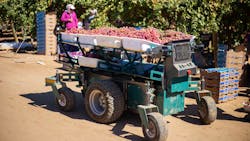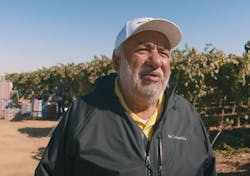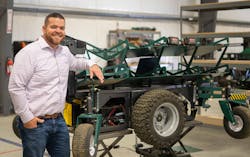Grape Harvesting is Ripe for Improvement
Slowly, silently, effortlessly. The autonomous grape cart does not necessarily attract much attention as it drives through the rows at Parminder Brar’s 900-acre family farm in Kern Country, Ca. But it has a big effect.
Parminder has volunteered to test the cart at his table grape farm this harvesting season. And his verdict is clear: The cart not only makes the workday for his seasonal employees a lot easier, but also drives up productivity.
With the cart between the rows, more human hands can focus on picking. They simply fill up the autonomous cart with boxes full of ripe table grapes as it passes.
Goodbye Bumpy Ride
This marks a big difference compared to the traditional method, where members of each picking crew collects the grapes in a wheelbarrow which is pushed through the rows.
“The rows are 100 meters long. Pushing the wheelbarrow is a dusty, sweaty job eating up a lot of time which this cart enables us to spend picking grapes instead,” said Brar. “We have six picking crews working in teams. If we had three or four carts for each crew, we would get a huge productivity boost.” Brar added that the carts seem robust and reliable easily navigating around any obstacles.
The carts, brand-named Gopher IQ, fulfill California startup Vinergy’s goal: to increase profitability for farmers of hand-picked specialty crops, including table grapes, blueberries, peppers and other produce by using rechargeable electric machines. The company was founded in 2019, launching a semi-automatic version of the cart the same year. Now they are about to hit the market with the self-driving version—one of the first-ever autonomous vehicles in the specialty farming market.
“I am extremely proud. With our Gopher IQ cart, we can improve productivity for an average picking crew as much as 30%,” said Justin Meng, president and CEO at Vinergy. “This translates into real savings for the farmer. It also frees up available hands. And this is key right now as farmers across the U.S. wrestle with labor shortages and rising wages.”
The plan is for the carts to be available on a rental basis for a monthly fee that includes service. Vinergy aims to have the first 60 to 75 carts available next harvesting season and to ramp up from there.
Converting Sensors to Solutions
Vinergy teamed with Berendsen Fluid Power to design the cart’s electric drive and control system, which includes components such as batteries, electric motors and advanced sensor technology.
Danfoss supplied the intelligent display DM1000 that includes a powerful computer with the Danfoss PLUS+1 Guide software inside. The software was customized to fit Vinergy’s needs. The computer and software together make up the digital brain converting sensor signals to physical movements, thereby enabling the cart to navigate the grape rows autonomously.
“The software part of autonomous driving is difficult. Reliability and safety are incredibly important. It is relatively untrodden territory, and few companies master it. Danfoss does,” said Mike Kelly, mobile sales director at Berendsen Fluid Power. “Partnering with them, we were able to bring this solution to market fast. And we are ready for a ramp-up.”
The cart is equipped with a LiDAR (Light Detection and Ranging) sensor with a 270-deg. field-of-view. The sensor uses laser light to monitor the area in front as it drives through the grape rows. If an obstacle or person is detected, the cart automatically finds a way around. If it cannot detect an alternative path, it stops. The PLUS+1 Guide software and the computer inside the DM1000 display constantly process sensor signals converting them to physical movements of the cart.
Vinergy already has several customers among fruit growers across California using its semi-automatic grape cart—and are negotiating with potential ones in Mexico and Peru. A handful of California farmers are currently testing the autonomous version, including Parminder Brar.
“We are impressed by the cart’s effectiveness and plan to lease several of them next harvesting season,” he said. “There is no doubt in my mind that autonomous machines will play a growing role at our farm in the future.”
Article courtesy of Danfoss; published with permission.





